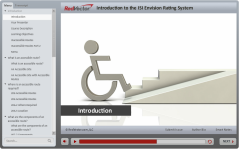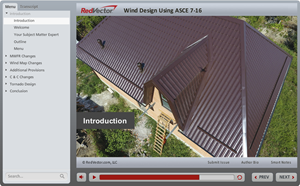Architecture and Design Continuing Education
Our online accredited courses equip architects and design professionals with the technical skills, safety knowledge, and continuing education needed to stay licensed, meet project demands, and deliver compliant, high-quality work across every phase of design and construction projects.

Speak to an Expert
Learn more about our courses, get pricing, and see our platform.
Discover Some of Our Most In-Demand Courses
- Accessibility and Visitability
- Accessibility by Building Type: Multi-Use Facilities
- Accessibility by Building Type: Universal Residential Design
- Accessible Design: Curb Ramps, Ramps, and Elevators
- Accessible Parking
- Accessible Restrooms
- Accessible Routes: Getting In, Out, and Around
- Accessible Signage
- ADA Guidelines 2010: Communication Elements and Features
- ADA Guidelines 2010: General Site and Building Elements
- ADA Guidelines 2010: Plumbing Elements and Facilities
- ADA Guidelines 2010: Recreational Facilities
- ADA Guidelines 2010: Small Towns
- ADA Guidelines: Achievable Barrier Removal and Accessibility (B)
- ADA Guidelines: Designing Pedestrian Facilities using Public Right of Way Accessibility Guidelines (PROWAG)
- Complete Streets - An Introduction to the Complete Streets Concept
- Complete Streets - An Introduction to the Design of Complete Streets
- Conflicting and Non-Existent Accessibility Standards
- Oregon Electrician 2020 NEC Changes: 2 Hour Program #4
- Oregon Electrician 2020 NEC Changes: 2 Hour Program #5
- 2015 International Building Code Essentials – Structural Safety
- 2015 International Energy Conservation Code - Commercial Essentials
- 2015 International Residential Code® Essentials - Protection, Utilities, Conservation, and Hazards
- 2017 NEC Changes: General Requirements
- 2017 NEC Changes: Special Equipment
- 2021 International Building Code & More: About the Codes
- 2021 International Building Code & More: Assembly Spaces
- 2021 International Building Code & More: Care Facilities Provisions
- 2021 International Building Code & More: Construction Types and Building Sizes
- 2021 International Building Code & More: Family Residences, Existing Structures and Historic Buildings
- 2021 International Building Code & More: Finish and Furniture Selection
- 2021 International Building Code & More: Fire Protection Systems
- 2021 International Building Code & More: Means of Egress
- 2021 International Building Code Essentials: Code Administration, Enforcement, and Building Planning
- 2021 International Building Code Essentials: Fire Safety
- 2021 International Building Code Essentials: Health Safety
- 2021 International Building Code Essentials: Life Safety
- 2021 International Building Code Essentials: Structural Safety
- 2023 Florida Advanced Building Code: Accessibility Scoping Requirements, 8th Edition
- 2023 Florida Advanced Building Code: Accessibility, Application, and Administration, 8th Edition
- 2023 NEC® Changes: Code-Wide Changes, New and Deleted Articles and Definitions
- 2023 NEC® Changes: General Requirements
- Anatomy of Construction Defects
- AR - 2023 NEC Changes: Chapters 1-3 (PGM)
- AR - 2023 NEC Changes: Chapters 4-7 (PGM)
- ASHRAE Essentials - 62.1-2016 Ventilation for Acceptable Indoor Air Quality
- ASHRAE Essentials: 55-2017 – Thermal Environmental Conditions for Human Occupancy
- ASHRAE Essentials: 90.1-2016 - Energy Standard for Buildings Except Low-Rise Residential Buildings
- Designing Foundation Repairs
- Florida - Wind Design and Wind Mitigation Requirements
- Florida Building Inspector's Laws and Rules 1
- Florida Landscape Architects' Laws, Chapter 481
- Florida: Building Inspector's Laws and Rules 2
- International Building Code & More: Fire Protection Systems
- MT - 2023 NEC Changes: Chapters 1-3 (PGM)
- MT - 2023 NEC Changes: Chapters 4-7 (PGM)
- NC - 2023 NEC Changes: Alternative Energy and Fire Pumps/Emergency Systems (PGM)
- NC - 2023 NEC Changes: Branch Circuits and Devices/Panelboards (PGM)
- NC - 2023 NEC Changes: General Requirements for Electrical Installations, Wiring Methods, Conductors, and Enclosures (PGM)
- NC - 2023 NEC Changes: Special Occupancies and Special Equipment (PGM)
- NC - 2023 NEC Changes: Wiring Methods and General Use Equipment (PGM)
- OR - 2023 NEC Changes: Alternative Energy and Fire Pumps/Emergency Systems (PGM)
- OR - 2023 NEC Changes: Branch Circuits and Devices/Panelboards (PGM)
- OR - 2023 NEC Changes: General Requirements for Electrical Installations, Wiring Methods, Conductors, and Enclosures (PGM)
- OR - 2023 NEC Changes: Special Occupancies and Special Equipment (PGM)
- OR - 2023 NEC Changes: Wiring Methods and General Use Equipment (PGM)
- Oregon Electrician 2020 NEC Changes: 2 Hour Program #1
- Oregon Electrician 2020 NEC Changes: 2 Hour Program #2
- Oregon Electrician 2020 NEC Changes: 2 Hour Program #3
- Past, Present and Future of Building Energy Codes and DOE Appliance Mandates
- Reinforced Masonry Design
- Soils and Foundations: The Low Down on Dirt
- The Importance of the International Building Code (IBC) in the Design and Construction of Safe Buildings
- Virginia 2017 NEC 3 Hour CE Program #2
- Virginia 2017 NEC 3 Hour CE Program #3
- Virginia 2017 NEC 3 Hour CE Program #4
- WA - 2023 NEC Changes: Alternative Energy and Fire Pumps/Emergency Systems (PGM)
- WA - 2023 NEC Changes: Branch Circuits and Devices/Panelboards (PGM)
- WA - 2023 NEC Changes: General Requirements for Electrical Installations, Wiring Methods, Conductors, and Enclosures (PGM)
- WA - 2023 NEC Changes: Special Occupancies and Special Equipment (PGM)
- WA - 2023 NEC Changes: Wiring Methods and General Use Equipment (PGM)
- Wind Design Using ASCE 7-16
- 10 Strategies for Improving Engineering Competence
- An Introduction to Fitwel®
- Bollard Boot Camp - How to Protect Places and People From Vehicle Incursions
- Building Design and Construction Features for Fire Protection
- Building Performance: Design Through Operations
- Climate Change Financing
- Coastal Engineering: Hurricanes and Nor'easters
- Coastal Engineering: Sea Level Rise
- Design of Bicycle Facilities - Buffered Bike Lanes
- Design of Bicycle Facilities - Multi-Use Paths
- Design of Utility Infrastructure
- Designing Permanent Erosion and Sediment Control Systems
- Designing Temporary Erosion and Sediment Control Systems
- Designing Using LRFD Principles
- Designing with Structural Composite Lumber
- Electrical Fire Alarm Systems
- Ethics and Liability – The Unintended Consequences
- Ethics for Engineers - A Moral or Legal Responsibility?
- Examining the Ethical Requirement to Hold Paramount Safety, Health, and Welfare
- Fire Essentials and Fire Science
- Fire Water Systems – Storage, Pumping & Distribution
- Geodesign for Sustainable Planning
- Grading and Drainage Design of Modern Roundabouts
- Green Design and Ethical Decision-Making
- Green Design: Introduction to Sustainable Water Systems (Based on LEED v4)
- Green Street Retrofit
- HVAC Acoustics
- Hydraulic Design of Storm Sewers
- Innovative Heat Pump Technology
- LEED v5 for Cities and Communities
- LEED® v5 Certification Process
- LEED® v5 for Neighborhood Development (ND): Sustainable Community Planning
- LEED® v5 Green Building Materials and Resources
- Making Practical Use of the NSPE Code of Ethics for Engineers
- Plumbing: Backflow Preventers
- Prestressed and Reinforced Concrete: Choosing the Best Method for Your Project
- Principles of Professional Construction Management
- Protecting People Against Terrorist Attacks: Design Considerations for Safe Rooms and Shelters
- Protecting Water Systems Through Backflow Prevention
- Selection, Specification and Installation of Safety and Security Barriers and Bollards
- Structural Design for Earth, Wind, and Fire
- Structural Design Philosophies ASD & LRFD
- The Aesthetics of ADA Accessibility
- The WELL Building Standard
- Transportation Engineering: Highway Capacity
- Transportation Engineering: Traffic Flow Theory
- Unreinforced Masonry Design
- Water-Based Fire Suppression Systems
- ASHRAE 100: Energy Efficiency in Existing Buildings
- Biofilters: A Natural Approach to Storm Water Pollutant Removal
- Building a Sustainable Future
- Cogeneration Systems Essentials
- Ethics: Shades of Green
- Green Building with Steel - Part 3: Light Gauge Metal Components for Framing
- Green Design: Brownfield Redevelopment (RV-10900)
- Green Design: Economics of Green Building
- Green Design: Introduction to High Performance Building Design (Based on LEED v4)
- Green Design: Introduction to Indoor Environmental Air Quality (Based on LEED v4)
- Green Design: Introduction to Sustainability and Measurement Systems (Based on LEED v4)
- Green Design: Introduction to Sustainable Design Materials and Resources (Based on LEED v4)
- Green Design: Introduction to Sustainable Sites (Based on LEED v4)
- Green Landscape Design: Reducing the Urban Heat Island Effect
- Green Landscape Design: Water Conservation in the Landscape
- Green Urban Design
- Increasing Building Energy Efficiencies: Policies and Practice
- Introduction to Net Zero Buildings
- Introduction to Rain Gardens
- Introduction to Sustainable Roof Technologies
- LEED v4 - Operations and Maintenance
- LEED v4 for Existing Buildings: Operation & Maintenance (EBOM)
- LEED v4 for Interior Design + Construction
- LEED v4 for New Construction Projects
- LEED v4: Building Design and Construction
- LEED v4: Residential Homes
- LEED: Water Efficiency
- LEED® v5 for Building Design and Construction (BD+C) Advanced Strategies
- Phytotechnologies: Using Plants to Clean Up
- Structural Insulated Panels (SIPs)
- Sustainable Building Technology
- Sustainable Design: Eco-efficiency of Roofing Insulation Systems
- Sustainable Solutions: Air Pollution
- Sustainable Solutions: Human Health and Well-Being
- Sustainable Solutions: Loss of Biodiversity
- Sustainable Solutions: Urban Flooding and Water Pollution
- Sustainable Solutions: Water Shortages
- Understanding Concrete's Environmental Advantage
- USGBC® LEED® v5 Update: Key Changes and Implications











